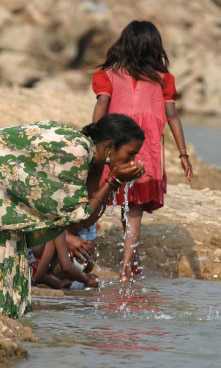Cholera in Southeast Asia
 The Southeast Asia Region, which includes Bangladesh and India, has the largest populations at risk for cholera 1. Reported cases in Asia increased nearly threefold from 2010 to 2011 and included an increased number of deaths 2.
The Southeast Asia Region, which includes Bangladesh and India, has the largest populations at risk for cholera 1. Reported cases in Asia increased nearly threefold from 2010 to 2011 and included an increased number of deaths 2.
Many countries in the Southeast Asia Region face challenges with known risk factors for cholera outbreaks including poverty, lack of development, and high population density 3. Additionally, the region is susceptible to extreme environmental factors, such as frequent and widespread flooding, that can contaminate water sources and dislocate populations.
Similar to Africa, improving global access to water, sanitation and hygiene (WASH) is a critical step to reducing cholera in the Southeast Asia region.
Cholera in Southeast Asia — Topics
Publications, Data, & Statistics
References
- Ali M, Lopez A, You Y, Kim Y, Sah B, Maskery B, Clemens J. The global burden of cholera. Bull World Health Organ. 2012;90:209-18A.
- WHO. Cholera 2011. [PDF - 16 pages] Wkly Epidemiol Rec. 2011;87:289–304.
- Ackers ML, Quick RE, Drasbek CJ, Hutwagner L, Tauxe RV. Are there national risk factors for epidemic cholera? The correlation between socioeconomic and demographic indices and cholera incidence in Latin America. Int J Epidemiol. 1998:27:330–4.
- Page last reviewed: November 7, 2014
- Page last updated: November 7, 2014
- Content source:


 ShareCompartir
ShareCompartir